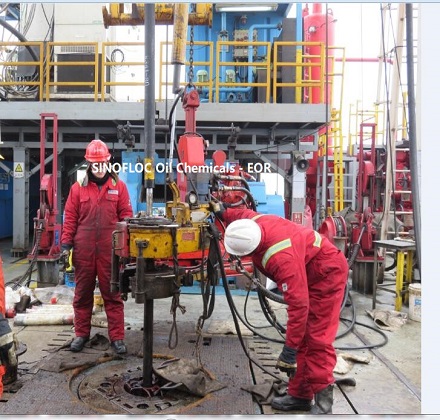Polymer is a substance that greatly increases the viscosity of the liquid which mixed with this polymer and water. Polymer flooding is mainly to use polymer to increase the viscosity of injected water, reduce the ratio of oil to water flow, and increase sweep efficiency. Firstly, from the rheology of the polymer, it can be seen that the viscosity of the water increases significantly after adding the polymer, and the higher concentration of the polymer, the stronger of the viscosity. In addition, when the rock surface is hydrophilic, the polymer is easily adsorbed on the surface. When the injected water passes through the surface of the adsorbent layer, the thin film of the adsorbent layer expands, thereby reducing the effective permeability of the aqueous phase. When the oil comes into contact with the adsorbent layer, no swelling will occur. Therefore, in oil layers with very low oil saturation, the use of polymers can significantly reduce the flow of water, increase the sweep efficiency, and improve oil recovery.
Secondly, Polymer suppresses the intrusion of the injecting solution and enlarges the effect of spreading the area. Since the polymer solution that protrudes in the direction of the main flow line has a higher viscosity and the adsorption and trapping of the polymer, the water-phase permeability is decreased, so that the fluid velocity of the polymer flooding is weakened relatively to the water flooding. There also exist polymer solution in the two wings of the mainstream line, however, the concentration is relatively low, and the effect is relatively small. Since the pressure gradient of the mainstream line is larger than the water flooding, the polymer flooding fluid flow velocity is relatively larger than water flooding and it is more biased towards the two wings. Therefore, the effect of spreading to the two wings was expanded, the area of sweeping was increased, and the degree of spread was deepened.
In terms of micro-displacement, exist of residual resistance and the decreased ratio of water-oil flow, the polymer can be used to displace the clustered residual oil. Polymer flooding increases the viscosity of the displacing phase, lowers the ratio of water-oil flow. Due to the considerable molecular weight of the polymer, the polymer flooding retains in the rock, increasing the flow resistance of the displacing phase fluid in the porous medium, which causes a decrease in the permeability of the aqueous phase and further reduces the ratio of water-oil ratio. Thereby increase the microscopic sweep efficiency and displacing the clustered residual oil after water flooding.
Furthermore, the increase in shear stress allows the polymer to displace island-like, film-like residual oil. When the polymer solution and the injection water respectively flow over the island-like, film-like residual oil surface, the shear stress of the polymer solution on the residual oil will be much greater than the shear stress of water on the residual oil. That’s why the polymer can drive island-like and film-like residual oil away.
